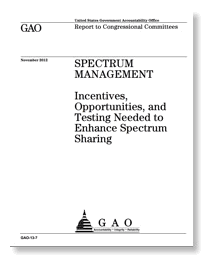GAO Report on Spectrum Sharing
GAO writes,
While federal spectrum users often share spectrum among themselves, they may have little economic incentive to otherwise use spectrum efficiently, including sharing it with nonfederal users. From an economic perspective, when a consumer pays the market price for a good or service and thus cannot get more of it without this expense, the consumer has an incentive to get the most value and efficiency out of the good as possible. If no price is attached to a good—which is essentially the case with federal agencies’ use of spectrum14—the normal market incentive to use the good efficiently may be muted. (p. 11)
Actually while it is true that “federal spectrum users often share spectrum among themselves”, this is mostly due to pressure from Congress and OMB, not so much from NTIA leadership or the collective interest of federal agencies who generally would just like to have their own systems regardless of financial or spectrum efficiency. But the availability of “free spectrum” has warped the decision making process in federal agencies since the marginal cost of spectrum is always less than the marginal cost of more efficient technology.
Echoing the findings of the controversial PCAST report, GAO writes
We have previously reported that to improve spectrum efficiency among federal agencies, Congress may wish to consider evaluating what mechanisms could be adopted to provide better incentives and opportunities for agencies to move toward more efficient use of spectrum, which could free up some spectrum allocated for federal use to be made available for sharing or other purposes.
The report ends with 3 recommendations for FCC NTIA action:
• Report their agencies’ views and conclusions regarding spectrum usage fees to the relevant congressional committees, specifically with respect to the merits, potential effects, and implementation challenges of such a fee structure, and what authority, if any, Congress would need to grant for such a structure to be implemented.
• Based on the findings of current research and development efforts under way, determine how the federal government can best promote federal and nonfederal investment in the research and development of spectrally efficient technologies, and whether additional spectrum is needed for testing new spectrum efficient technologies.
• Evaluate regulatory changes, if any, that can help improve and expedite the spectrum sharing process.
Will this report have a major impact on spectrum sharing? Probably not. But this report adds to the weight of the PCAST report with respect to the problems of federal spectrum management. These problems arise not from the lack of public interest in the NTIA staff and IRAC membership, rather than the fact that the present 1978 NTIA structure is unrealistic in view of the current demands for spectrum from all public and private parts of our society and economy and the new technical options for sharing that just were not even a pipe dream when the 1978 framework was put in place in the Carter Administration.




![Validate my RSS feed [Valid RSS]](valid-rss-rogers.png)

